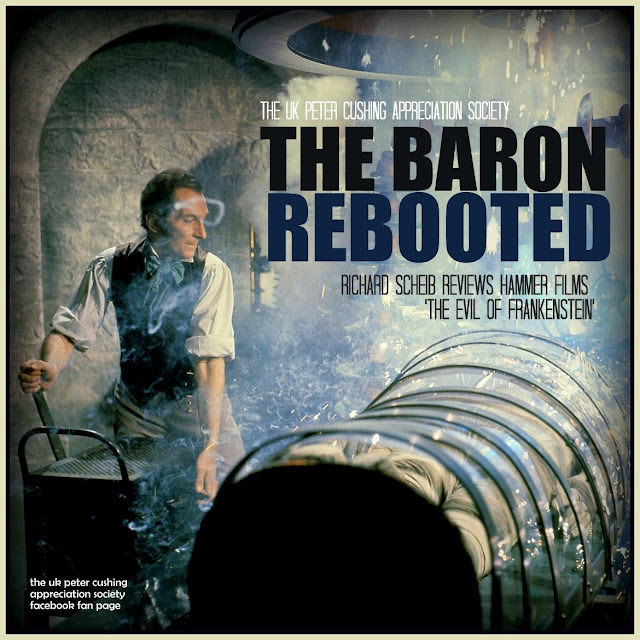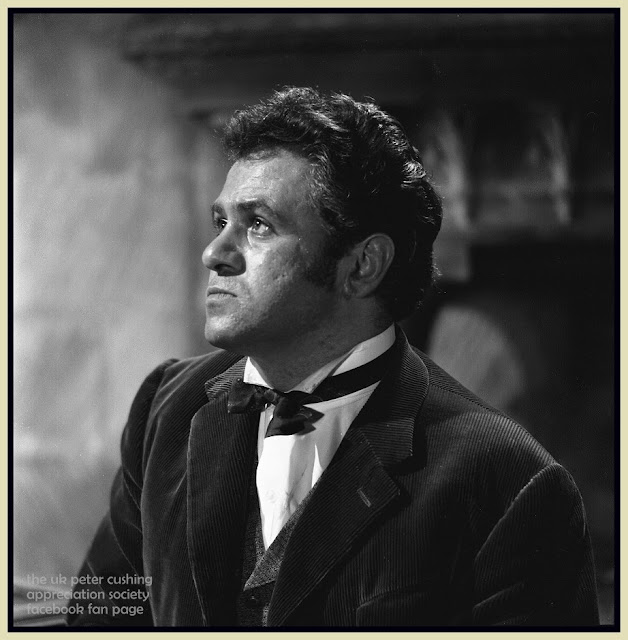CAST:
Peter Cushing (Baron Frankenstein), Peter Woodthorpe (Zoltan), Sandor Eles (Hans), Kiwi Kingston (The Monster), Katy Wild (Rena)
PRODUCTION:
Director – Freddie Francis, Screenplay – John Elder [Anthony Hinds],
Producer – Anthony Hinds, Photography – John Wilcox, Music – Don Banks,
Special Effects – Les Bowie, Makeup – Roy Ashton, Art Direction – Don
Mingaye. Production Company – Hammer.
SYNOPSIS:
Forced to leave town because of their
experiments, Frankenstein and Hans return to Frankenstein’s hometown
Karlstad and set up laboratory in the abandoned Frankenstein chateau.
Frankenstein then finds his original creation frozen inside a glacier
and restores it to life. Only it will not respond to his commands. And
so Frankenstein comes up with the idea of obtaining the services of
Zoltan, a disreputable carnival hypnotist, to hypnotize the monster into
obeying him. Zoltan is successful but has less than scientific
interests at heart. With the monster responding only to his commands,
Zoltan uses it to rob and take revenge upon the town authorities.
COMMENTARY:
General opinion holds The Evil of Frankenstein,
the third of Hammer’s Frankenstein films, to be one of the duds of the
series. One is at a loss to understand why. I, to the contrary, hold The Evil of Frankenstein to be one of the best of the series. With the preceding two entries, The Curse of Frankenstein (1957) and The Revenge of Frankenstein
(1958), Hammer had kept the same essential creative team – director
Terence Fisher, screenwriter Jimmy Sangster and star Peter Cushing – in
place. For The Evil of Frankenstein,
Hammer producer Anthony Hinds replaced Sangster on script, while
Freddie Francis inherited the director’s chair. Freddie Francis was an
up and coming director who had worked as an award-winning
cinematographer in the previous decade, had made his genre debut with Vengeance/The Brain (1962), followed with a couple of Hammer’s psycho-thrillers, Paranoiac (1962) and Nightmare (1963), and then attained some success with the first of Hammer rival Amicus’s anthology films Dr Terror’s House of Horrors
(1964) just prior to this. Francis, whose output to the Anglo-horror
cycle has been underrated, would go on to become its next most prolific
director to Fisher. (See below for Freddie Francis’s other films).
It is not clear why The Evil of Frankenstein
is almost universally regarded as such a dog in the Hammer pantheon.
Just look at the opening scenes that hit one with the fervid intensity
of something out of a Hieronymous Bosch nightmare brought to life – a
little girl sees a body being stolen from a hut in the forest in the
middle of the night and calls a priest. The body is taken to
Frankenstein who removes the heart before the paling body snatcher,
dismissing his queasiness with a curt, “He won’t need it anymore,”
before the priest bursts in, cursing Frankenstein’s abominable
experiments and smashing the lab equipment. It’s a sequence lit with
such a feverishly eerie intensity that it attains a genuinely nightmare
atmosphere of dread chill. Nothing else in the film quite manages to
match it. Certainly, there are a number of images littered throughout
that have a lingering memorability – the deaf-mute beggar girl and her
strange relationship with the monster; the monster found buried in the
side of the glacier; and one especially memorable scene where the
monster gets up and begins to agonizingly shuffle around the lab while
Frankenstein looks on, coldly clinically taking notes.
The Evil of Frankenstein
presents some confusion to the continuity of the Hammer Frankenstein
series. For some reason, Freddie Francis conducts a flashback that
offers a potted retelling all the essentials of The Curse of Frankenstein
anew. However, this makes changes to continuity – Frankenstein now
appears to have merely been driven out of town, not executed. Where the
events of The Revenge of Frankenstein fit in becomes somewhat confusing – the Hans character is carried over from Revenge,
but Frankenstein’s new body and his escape from the gallows is
forgotten about. It’s a puzzle as to why the film creates the flashback –
some of this is to set up plot points for later on – although without
much rewriting this could all have been made to carry over from Revenge.
What tended to lose many people was the addition of the Zoltan
character, which takes the story considerably away from the Frankenstein
mythos. Indeed, you could almost see this as Hammer’s attempt to craft
their own variant on The Cabinet of Dr Caligari (1919).
With The Curse of Frankenstein, Hammer did not have the copyright to use the Jack Pierce designs for the Boris Karloff monster makeup from Frankenstein
(1931) and so Phil Leakey came up with his own original designs.
Apparently Universal has relaxed their copyright restrictions by the
time of The Evil of Frankenstein and
the makeup on Kiwi Kingston’s monster is closely modelled on the Pierce
designs, the only time the Hammer Frankenstein’s came close to
resembling the Universal originals. Production designer Don Mingaye and
special effects man Les Bowie collaborate to come up with not one but
two of the series very best creation sequences, with lightning bolts and
generator coils crashing in the best Kenneth Strickfaden tradition. And
on the whole, The Evil of Frankenstein is a Hammer Frankenstein entry that is well worth re-evaluation.
The other Hammer Frankenstein films are:– The Curse of Frankenstein (1957), The Revenge of Frankenstein (1958), Frankenstein Created Woman (1967), Frankenstein Must Be Destroyed (1969), The Horror of Frankenstein (1970) and Frankenstein and the Monster from Hell (1973).
Freddie Francis’s other genre films are:- Vengeance/The Brain (1962), Paranoiac (1962), Nightmare (1963), Dr Terror’s House of Horrors (1964), Hysteria (1965), The Skull (1965), The Psychopath (1966), The Deadly Bees (1967), They Came from Beyond Space (1967), Torture Garden (1967), Dracula Has Risen from the Grave (1968), Mumsy, Nanny, Sonny and Girly (1969), Trog (1970), The Vampire Happening (1971), Tales from the Crypt (1972), Tales That Witness Madness (1972), Craze (1973), The Creeping Flesh (1973), Legend of the Werewolf (1974), Son of Dracula (1974), The Ghoul (1975), The Doctor and the Devils (1985) and Dark Tower (1987).
Review: Richard Scheib














